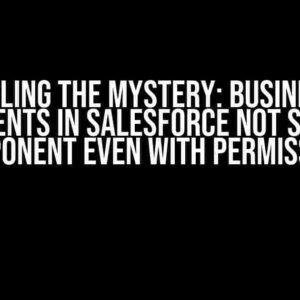Are you experiencing the frustrating issue of TimeFold VariableListener corruption after initial score calculation? You’re not alone! This phenomenon has been plaguing developers and data analysts alike, causing headaches and lost productivity. Fear not, dear reader, for we’re about to embark on a journey to conquer this pesky problem once and for all.
What is TimeFold VariableListener Corruption?
Before we dive into the nitty-gritty of troubleshooting, let’s take a step back and understand what’s happening when TimeFold VariableListener corruption occurs. In essence, this corruption manifests when the VariableListener, responsible for monitoring and updating variables in real-time, becomes desynced from the TimeFold system after the initial score calculation.
This desync can lead to a cascade of errors, including:
- Inaccurate score calculations
- Data inconsistencies
- System crashes or freezes
- Frustrated developers and stakeholders
Causes of TimeFold VariableListener Corruption
Now that we’ve established what’s happening, let’s explore the common causes of this corruption:
- Incorrect Configuration: Misconfigured TimeFold settings or VariableListener parameters can lead to desync issues.
- Data Overflow: Excessive data accumulation can overwhelm the system, causing the VariableListener to lose sync.
- System Resource Constraints: Insufficient system resources, such as RAM or CPU, can impede the VariableListener’s ability to function correctly.
- Software Conflicts: Incompatible software or plugins can interfere with the TimeFold system, leading to corruption.
- Human Error: Simple mistakes, such as incorrect data input or forgotten updates, can also contribute to the issue.
Troubleshooting Steps
Now that we’ve covered the causes, it’s time to get our hands dirty with some troubleshooting steps:
Step 1: Review Configuration and Settings
Double-check your TimeFold configuration and VariableListener settings to ensure they’re accurate and up-to-date. Pay close attention to:
- TimeFold version and compatibility
- VariableListener parameters and thresholds
- Data source connections and authenticity
<TimeFoldConfig>
<VariableListener>
<parameter name="threshold" value="100">
</parameter>
</VariableListener>
</TimeFoldConfig>Step 2: Monitor System Resources
Keep a close eye on system resource usage to identify potential bottlenecks:
| Resource | Threshold | Action |
|---|---|---|
| CPU | 80% | Optimize code or allocate additional resources |
| Ram | 4GB | Upgrade system memory or optimize data storage |
| Disk Space | 10GB | Clear unnecessary data or allocate additional storage |
Step 3: Isolate Software Conflicts
Identify and isolate any software conflicts that may be contributing to the issue:
- Disable any recently installed plugins or software
- Check for compatibility issues with other system components
- Consult with IT or system administrators for assistance
Step 4: Verify Data Integrity
Validate data input and ensure accuracy to prevent human error:
<DataInput>
<validation>
<rule>
<expression>"score">= 0</expression>
</rule>
</validation>
</DataInput>Resolution Strategies
Now that we’ve troubleshooted the issue, it’s time to implement resolution strategies:
Resolution 1: Re-Sync VariableListener
Re-sync the VariableListener with the TimeFold system to re-establish a stable connection:
<TimeFoldCommand>
<reSync>
<VariableListener>
<parameter name="threshold" value="100">
</VariableListener>
</reSync>
</TimeFoldCommand>Resolution 2: Implement Data Buffering
Implement data buffering to prevent overflow and reduce system load:
<DataBuffer>
<size>1000</size>
<timeout>300</timeout>
</DataBuffer>Resolution 3: Optimize System Resources
Optimize system resources to improve overall performance and reduce the risk of corruption:
- Upgrade system hardware or infrastructure
- Optimize code and algorithms for efficiency
- Implement load balancing or distributed processing
Conclusion
TimeFold VariableListener corruption after initial score calculation can be a frustrating and complex issue, but with the right troubleshooting steps and resolution strategies, you’ll be well on your way to resolving the problem and getting your system back on track.
Remember to stay vigilant, monitor system resources, and implement preventative measures to avoid this corruption in the future. Happy troubleshooting!
Frequently Asked Questions
Get answers to your burning questions about TimeFold VariableListener Corruption after Initial Score Calculation.
What is TimeFold VariableListener Corruption?
TimeFold VariableListener Corruption occurs when the VariableListener fails to update correctly after the initial score calculation, leading to incorrect results and potential data loss.
What causes TimeFold VariableListener Corruption?
The corruption can be caused by a variety of factors, including incorrect configuration, data inconsistencies, and conflicts with other system processes. Identifying the root cause is essential to resolving the issue.
How do I detect TimeFold VariableListener Corruption?
You can detect the corruption by monitoring system logs for error messages, checking for inconsistencies in data outputs, and verifying the accuracy of score calculations. Early detection is key to minimizing the impact of the corruption.
Can I prevent TimeFold VariableListener Corruption?
Yes, you can take steps to prevent the corruption by ensuring proper system configuration, regular data backups, and implementing quality control measures to detect potential issues early on.
What should I do if I encounter TimeFold VariableListener Corruption?
If you encounter the corruption, immediately cease system operations, contact technical support, and follow their guidance to restore the system to a stable state. It’s essential to act quickly to minimize data loss and prevent further damage.


